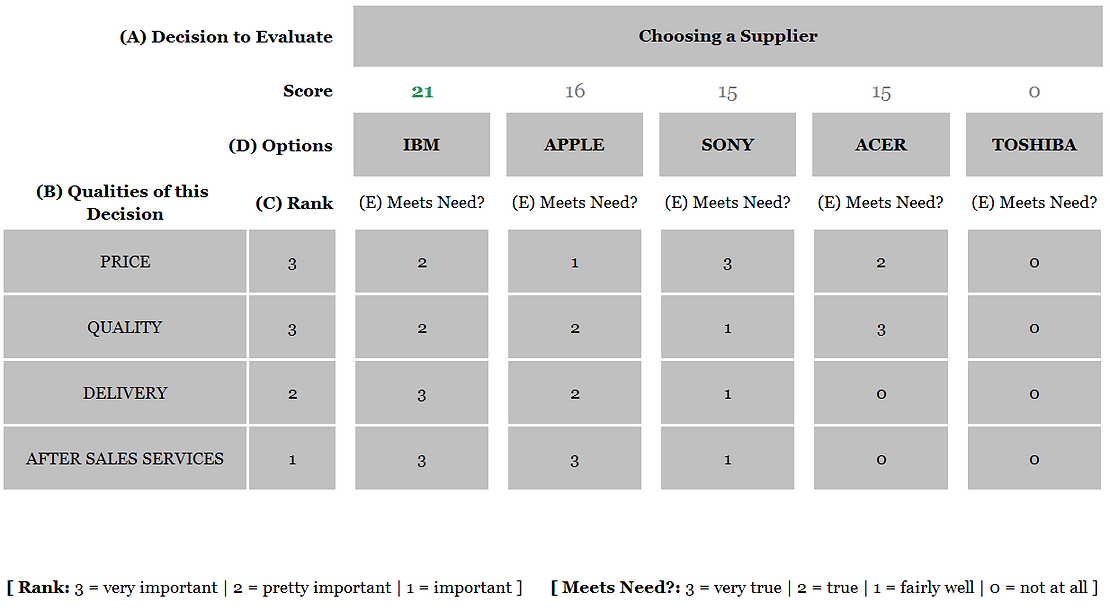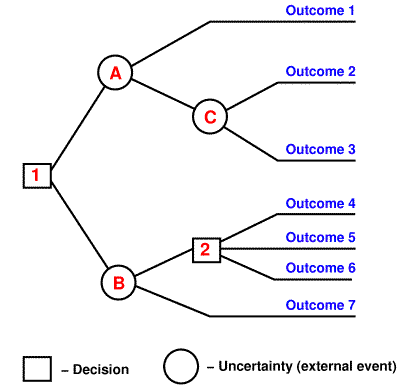Why Managers Should Consider Using Algorithms?
Decision-making is what distinguish a managers from any other executive in the organization. In hierarchical organization, the main difference between the junior executive till the top senior managers is about the quality of decisions they make. As depicted in the following figure, the career path of an employee is projected as ladder of decisions & executions.
The major responsibility of the worker who is at the first steps of that ladder is to execute decisions that are already made by whom on the higher steps of that ladder, while those junior executive are delegated to handle small percentage of decision making, and those decisions are about choosing the best tactic to execute senior managements’ decisions, what we call Operational Decisions, where those kind of decisions are limited in impact.
Read also Behavioral Change in Organizations
As higher is the career level of the executive as less execution he/she handles and the more impact, cost and risky decisions he/she makes, till reaching the highest executive level in such organization, where the main rule of a CEO is making Strategic Decisions, where the effects of those decisions have the strongest resonance that affect the entire company. Yet senior managers still have to take part of the execution process as well, for example when the CEO makes a strategic decision to invest in cement industry for the first time, so he is the one who takes responsibility to handle the execution of some of the critical parts of this plan, like meeting the secretary of industry to convince him to grant the company a license to establish a factory of cement. No one else can execute such mission except the top executive of the organization.

Therefore, the role of a manager can be defined as a mere decision maker, and amongst the most serious problems any manager faces when making decisions is human error – the inability to accurately estimate the status quo and the overwhelming influence of the so called – Cognitive Biases & Heuristics, which both refer to the tendency of human beings to take shortcuts to save the brain’s energy while deciding about something, plus the instinctive inclination of human brains to measure and analyze situations under a systematic pattern of deviation from logic and rationality, so the outcome is biased and irrational decisions. Many researches aimed to classify those cognitive biases, in which some estimated that our brains embrace more than fifty biases that fall under four categories;
- Too Much Information.
- Not Enough Meaning.
- Need To Act Fast.
- What Should We Remember?
A close focus on specific information would cause the omission to other information that has a significant importance, so it leads to catastrophic decision. This bias is called Availability Heuristic. Also people tend to gather scattered and unrelated data and they build out of it a full structure of uniform storyline by which they comprehend they can connect the dots, and picture series causes and effects that led to the existence of these data, and based on this story that seemed logic and rational, a decision is made accordingly, and after the turmoil, they find out that the decision was wrong, which was based on a story that never happened because it was based on data that were never related to each other, and this is what psychologists define as Anecdotal Fallacy.
Then, it comes the moment when the investor has to swiftly decide whether to get rid of a losing bond or to continue risking by holding position. In these critical moments, the majority of people make a decision to keep the holding position so to avoid losing their investment even if there are strong signals of an inevitable loss, but they completely ignore such signals, and this is called Endowment Effect and Loss Aversion. And finally, we always tend to choose a specific item from a long list, yet coincidentally that item is always placed at the end of the list, and this bias is called Suffix Effect, also ignoring some details in order not get the brain tired and to keep the easy and the abstract view of an information, and this bias is called Implicit Association Bias.

Since the midst of the last century, and as a result of the increasing development of algorithms in computer science, many researchers were encouraged to conduct various experiments to compare decisions made by humans and to the decisions made by computer (algorithms). Surprisingly at that time, results always favored algorithms over humans when making the right decisions, even in some unexpected areas, where humans are more trusted than the machine – the medical diagnosis. A study titled Clinical Versus Mechanical Prediction: A Meta-Analysis, where they gathered about 136 medical studies that compared the diagnosis of physicians and to an algorithm diagnosis system. The result was favoring the accuracy of algorithms over physicians in some of these studies by 10% and in others by 47% more accurate.
We all recall how algorithms finally defeated Garry kasparov the genius chess master, when he accepted the challenge against Deep Blue 2. We are all currently witness to how the self-driving Tesla cars that are based on algorithms are scoring much better safety rates on the roads and much less accidents comparing to human driving.
But this fact doesn’t mean that algorithms already surpassed human intelligence. Still this marvelous mind embraces indisputable capabilities that no artificial intelligence would compete with. The capacity of the human brain to innovate, contemplating, solving problems, picturing multiple scenarios for future events, these are the faculties of the mind where no algorithms could approach till now.
However this mind hasn’t been designed to solve millions of mathematical equations in couple of seconds, or to analyze hundreds of scattered data at once. Algorithms excel in these issues, as well algorithms surpass humans by having a natural capability to bypass the emotional barrier and cognitive biases that has been inculcated in the human being since his first creation (yet it’s what made him a human). One of the simplest kind of algorithm humans used since early times so to reduce the effect cognitive biases and emotions while making decisions, was consultation. Sharing opinions about a certain decision is enough to dampen the numerous biases and emotions that invade individuals when they make such decision in a group, that’s why Islamic jurisprudence enhanced such tactic to rule and manage peoples’ issues.
In today’s business world, making the right decisions became the number one trait of any successful manager in whatever discipline. New problems are emerging every day in which they necessitate what is more than intuition and trusting personal experience to make a decision. It rather demands the help of algorithms so to reduce human error and ensure the sustainability of making right and sound decisions most of the time.
We don’t mean complicated non-linear mathematical equations when we refer to algorithms, rather simple mathematical principles that anyone can harness using spreadsheet software i.e. Excel. And this is the inner core of algorithms, they are nothing more a principle wearing the cloak of an equation that could be demonstrated in the simplest format of variables that clearly show the real cause and effect, while it could reach to a complexity of a one million line of programming code. Algorithms will never get it right for 100% of times, because variables that surround the decisions are infinite, also variables that emerges between the decision making and decision execution are also numerous. The target of using algorithms is to help the decision maker to go through the most optimal path by encompassing and comprehending all the available inputs, giving them the correct relative weights and diminishing any kind of emotional stimulation or cognitive biases that may give incorrect weight or focus. And even if the decision didn’t work out well sometimes, yet is better for the long run to use a system of decision making built on a rational and accurate mechanism even if it sometimes misses the target, where it’s still much better than decisions that popped out as a result of faulty personal opinions that for sure will fail on the long run even if sometime it hit the bull’s-eye.
We shall dig in some examples of algorithms that can be easily used to solve lots of daily-work problems, by helping the decision maker to get it right and optimal, as follow;
1. Optimal Stopping with managers
The secretary problem is a famous mathematical dilemma that has been discussed a lot in various science journals. Imagine if you were a managers and you’d like to hire a secretary, so you received hundreds of application, so when you begin to interview the candidates, when shall you stop and pick up one of them? Bear in mind that the one you dismiss, you can’t get her back again. If you think to interview all of them before making the decision, so this is the worst decision ever you may make. This is okay when you meet couple of candidates, but what about choosing between tens or hundreds considering your limited time and resources? So, imagine you’ll interview three people, the first candidate is the best of them and the second is the mediocre and third is the worst, so you decided to refuse the first one who you meet and then you choose amongst the rest the best of them with condition to be better than the first one you already dismissed, by applying such algorithms you’ll have 50% chance to get the best candidate out of the rest. Your second strategy is to choose the best one of the next two people comparing to the first one, so how much is your chance to get the best candidates? In this case, the chances to get the best one will decrease to 33%
(1)First Candidate – Best
(2)Second Candidate – Mediocre
(3)Third Candidate – The worst

So what about if they were four or five candidates even till reaching 1000 candidates, if you decide to scrutinize all the 1000 candidates till you reach the best of them will get you the same result when you chose the best one after the 37th of them as shown in the below table.
It means that if you always want to get systematic and fixed result of 37% chance to win, you have to choose directly the best candidate after dismissing 37% of the attendances.
The application of such algorithm in business and ordinary life are numerous. So next time when you feel confused about choosing the best between 100 items, so just cancel the first 37 of them and directly choose the next option that is better than the item number 37 and then stop searching.

2. Assessing multiple options
A managers usually has to study and assess handful of options and to choose the best of them, and he often gives a subjective assessment to an option or using his intuition to decide which option to choose. However psychological studies proved that there is a better and more accurate way to do so – a simple algorithm called Decision matrix Analysis, where you list the options and set a certain weight for each of them according to how much it represents and serves the main choice, and finally you choose the top resulted option.
Daniel Kahneman, the Nobel laureate for his contribution in Behavioral Economics, He set up a similar matrix when he served in the Israeli military in the fifties and till now it’s still applicable. He made a list of five to seven personal attributes in order to assess soldiers, and making a rank for each option, then gives each soldier a mark according to his answers for each attribute. Such technique would visualize the top traits a soldier has so they can allocate him to the unit that fits him the most.

3. Travelling Salesman Problem with managers
This problem is represented as one of the most renowned mathematical dilemmas, where it also has many of business applications, for example when a logistic manager controls a fleet of distribution trucks, one of his crucial missions is to set up the best route for each truck so it consumes less fuel and needs for less frequent maintenance, so the total results will be a bunch of saved cash, so what about if each truck has about twenty point of distribution all over the city, so which route is the best and the shortest to take?

There are lots of ready algorithms on Excel that can give a very good solution for such problem, some of them use neural networks or genetic algorithms (bear in mind that there is no single algorithm that has an optimal solution for this dilemma yet.)

4. Decision Tree
This algorithm has a very common usage in options evaluation, by charting the possible decisions in a form of squares, and branching out circles that represent the probabilities of each decision, and finally drawing branches that represent the final result of each decision in numbers, so we take each branch and estimate its result and compare it with other branches in net value managers.

The first example represents the simplest usage of a decision tree, where the two main decisions are about accepting two different job offers, the decision is represented as a square that splits into two branches, the first is about the offer with annual salary of $70,000, then comes the circle of probabilities, the chances to get accepted in this job is 20% while 80% is the probability of being rejected, and in case of rejection the candidate will have to continue in his old job where he gains $50,000 yearly. So the final result of both probabilities is $54,000.
Then we repeat the same with the second offer which is $60,000 yearly, and the chances of acceptance are 80% while chances of refusal are 20% which is contrary to the first offer. So the final result here will be $58.000 yearly. So, according to this algorithm, the second option of accepting the job offer of $60,000 yearly, which is more feasible.

Finally, the usage of algorithms became possible for ordinary people more than ever before, by having simple and cheap tools, it results to decisions that take into consideration all the inputs and options exist, in an objective and rational manner, while diminishing the negative humanistic influence of emotions and cognitive biases that act as a barrier to take the right decision at the right time.
you can join to our Marketing Diploma دبلومة التسويق النفسي



